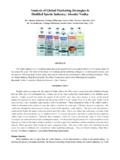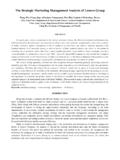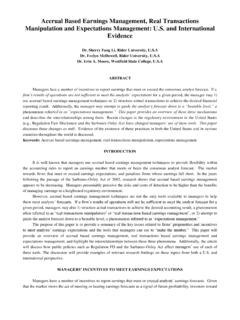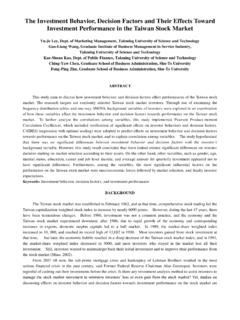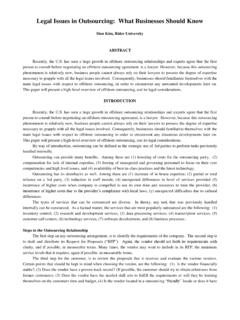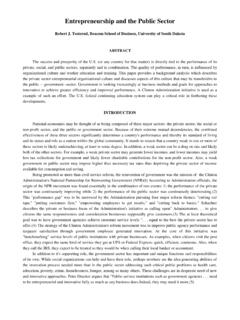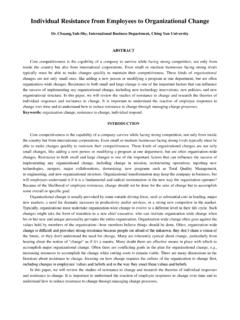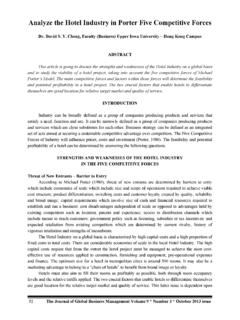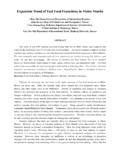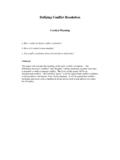Transcription of Conflict Resolution Strategies and Marketing …
1 Conflict Resolution Strategies and Marketing channel Relationships: Framework and Research Propositions C. M. Sashi, Florida Atlantic University, USA ABSTRACT Relationships in Marketing channels tend to be long-term oriented and members of the channel rely on each other to jointly realize their goals by serving buyers. Despite the channel s focus on serving buyers, conflicts often arise between channel members because of each member s self-interest. When conflicts arise, the perceptions of a channel member based on normative, rational/instrumental, or emotional reasoning will influence relational norms like trust and commitment that characterize the relationship between members. The relational norms in turn influence how conflicts are resolved and relationship quality. A theoretical framework to study Conflict Resolution in Marketing channels and its impact on channel relationships is developed by identifying the variables to represent channel member perceptions, relational norms, Conflict Resolution Strategies , and relationship quality.
2 Propositions linking these variables are developed and indicate how these variables influence one another when Conflict occurs. INTRODUCTION In recent years there has been a surge of interest in the study of relationships between buyers and sellers and indeed relationship Marketing has emerged as a new field of study (Sheth and Parvatiyar, 2000; Palmatier, Dant, Grewal, and Evans, 2006). The new emphasis on relationships has served to correct for an imbalance in the study of transactional and relational exchanges. While Marketing has focused on buyer needs at least since the Marketing concept gained acceptance, it has implicitly treated transactional exchange as the default mode of exchange, perhaps because of the ubiquity of transactional exchanges in consumer markets. But sellers in both consumer and business markets have long sought to establish relationships with their buyers.
3 Business markets in particular have been characterized by long-term relationships between organizations, especially in supply chains and Marketing channels ( , Keep, Hollander, and Dickinson, 1998; Cannon and Perreault, 1999). Decisions regarding the structure of the Marketing channel and choice of number and type of distribution intermediaries tend to be long-lived and are not easily changed unlike pricing and advertising decisions. channel members are regarded as partners who work together to satisfy buyers even though each intermediary may be regarded as buying from the preceding member in the channel of distribution. For instance, Procter & Gamble and Wal-Mart are partners working together to satisfy buyers though the former may be regarded as a manufacturer selling to the latter regarded as a retailer who sells to the consumer.
4 Wal-Mart could be considered Procter & Gamble s buyer and Procter & Gamble has to focus on Wal-Mart s need while Wal-Mart in turn focuses on its buyer s need. However, to prevent suboptimal results, Procter & Gamble and Wal-Mart must strive together as one interorganizational system to serve the consumer, not separately try to attain their individual goals. As a consequence, in long-term relationships like that between members of a Marketing channel , Conflict is inevitable and its Resolution will impact relationships among channel members. In Marketing channel relationships, one of the parties eventually will engage in an action that another channel member considers potentially destructive for the relationship (Hibbard, Kumar, and Stern, 2001, p. 45). Conversely, a channel member may consider another channel member s action as potentially constructive for the relationship.
5 Conflict has been studied from a variety of perspectives drawn from different disciplines including psychology, sociology, economics, political science, management, and Marketing (see, , Lewicki, Weiss, and Lewin, 1992). Research in Marketing channels has a tradition of focusing on Conflict and power as key constructs influencing distribution decisions and channel structure ( , Mallen, 1963; Assael, 1968; Stern (1969), Rosenberg and Stern, 1970; 1971; Etgar, 1976; Lusch, 1976; Brown and Day, 1981; Gaski, 1984; Dant and Schul, 1992; Kumar, Scheer, and Steenkamp, 1995; Hibbard, Kumar, and Stern, 2001; Vosgerau, Anderson, and Ross, 2008). However, only in recent years has the importance of norms like trust and commitment that characterize the relationship between organizations been recognized (Morgan and Hunt, 1994).
6 But little attention has been given to how these norms are affected by Conflict and in turn affect Conflict . In this article we develop a framework to study Conflict Resolution in Marketing channels that takes into account Conflict perceptions, relational norms, Conflict Resolution Strategies , and the relationship between channel members. We develop propositions to indicate how (1) Conflict perceptions based on normative, rational/instrumental, and emotional reasoning affect relational norms, (2) relational norms affect Conflict Resolution Strategies , and (3) Conflict Resolution Strategies affect Marketing channel relationships. Conflict Resolution IN Marketing channel RELATIONSHIPS Marketing channels are sets of interdependent organizations involved in the process of making a product or service available for use or consumption (Coughlan, Anderson, Stern, and El-Ansary, 2006, p.)
7 2). The organizations that are members of the channel work together to serve the buyer by performing the necessary functions that gives the product or service the ability to satisfy buyer needs. The channel members specialize in the functions performed and the value added, with each organization responsible for some of the characteristics required by buyers. The relationship among channel members has to be considered triadic rather than dyadic as it involves not just the members of the Marketing channel but also the buyer and the members engage in relational rather than transactional exchange (Narayandas, Caravella, and Deighton, 2002). Despite recognition that the interests of each member are best served by focusing on a third party, the buyer, members often focus on individual goals at the expense of the channel as an interorganizational system.
8 Interorganizational relationships are prone to Conflict because they are characterized by interdependence between members, perception by at least one member that there is some opposition or incompatibility among the goals of the members, and some form of interaction (Thomas, 1992). Conflict in Marketing channels has been defined as a situation in which one channel member perceives another channel member to be engaged in behavior that is preventing or impeding him from achieving his goals (Stern and El-Ansary, 1977, p. 283). If a channel member s actions are viewed as impeding another channel member s goals, Conflict will increase. On the other hand, if a channel member s actions are seen to facilitate the achievement of another member s goals, Conflict will decrease. A channel member s perceptions of Conflict will influence changes in the relational norms that characterize its relationship with other channel members.
9 Depending on how the relational norms change, the Conflict Resolution Strategies of the members will vary. The Strategies used by the parties to resolve Conflict will either improve or reduce the quality of the relationship among channel members. Conflict PERCEPTIONS In a seminal article on Conflict , Pondy (1967) identifies five stages of a Conflict episode: latent, perceived, felt, manifest, and aftermath. According to Gaski (1984), these stages represent a perceptual and a behavioral dimension of Conflict . A channel member s perceptions of another member s actions will be based on normative, rational/instrumental, and emotional reasoning (Thomas, 1992). We develop variables to measure Conflict perceptions based on each of these three modes. Perceptions of Conflict based on normative reasoning consider the goodness of the act itself that is, its normative acceptability (Thomas, 1992).
10 If a channel member perceives the action of another channel member to be fair, they will perceive it positively. If, however, the channel member perceives the action as unfair, they will perceive it negatively. A variable, Fairness, is introduced to measure the perceived fairness of the action. Rational/instrumental reasoning considers the desirability of the likely outcomes of a course of action. A course of action is considered desirable (and its choice is considered rational) if and only if it is seen as instrumental in producing a desired outcome (Thomas, 1992). If a channel member perceives the action of another member as beneficial to them, they will perceive it positively. But if it perceives the action as detrimental to their interests, they will perceive it negatively. A variable, Benefits, is introduced to measure the perceived benefits of the action.
